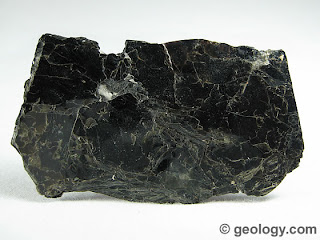Biotita com aproximadamente 10 centímetros de diâmetro.
É formada principalmente por processos magmáticos hidrotermais e metamórficos, exibindo evidências de mudanças composicionais como a variação da temperatura, pressão e composição litológica. Normalmente são encontradas amostras de biotitas em rochas sieníticas, granitos, veios pegmatíticos, gnaisses e rochas metamórficas em geral.
Devido a algumas características como, por exemplo, sua excelente clivagem placóide a biotita se rompe facilmente em finas lâminas flexíveis, pode ser também facilmente alterada pelo intemperismo químico em climas úmidos e quentes, dando origem a argilas que normalmente adquirem coloração especificas variando em tons de vermelho e amarelo devido à presença de quantidades variáveis de ferro e do estado de oxidação.
Entre outras aplicações cotidianas a biotita serve como participação de agregados de concreto leve; isolamento de paredes laterais de forros; isolamento em armazenagem à frio; isolamento de blocos de concreto; como enchimento em furos dos blocos de concreto. A mica moída é aplicada na produção de tintas e nas indústrias de materiais de transportes, eletrodos, cerâmica e na perfuração de poços de petróleo, etc.
Uma aplicação muito importante da biotita na vida das pessoas é seu uso em earthcaches, porém para que esse uso seja válido é importante que você responda a umas perguntinhas:
- Estime o comprimento da rocha da escultura
- Estime a porcentagem de biotita x albita na rocha da escultura
- A albita, como o nome sugere, é um mineral de coloração branca, porque vemos manchas de coloração amarelada nesta amostra?
Enve as respostas para o meu e-mail ou por mensagem, NÃO COLOQUE NO LOG. Se quiser tirar selfies e enfeitar o seu log com elas não tem nenhum problema.
Obrigado por visitar esse earthcache.
Here at this point we have a sculpture, of 1945, of Iole de Freitas, without name composed of Albita, mica, stainless steel, lead and copper. In this Earthcache we will learn more about mica, specifically about the biotite which is the geological feature of greatest prominence in this work.
Receiving this name in honor of the great French physicist Biot, the biotite is a common mineral of the class of silicates, mica group. Also called the Black mica, it constitutes together with Muscovite the most abundant types of micas in the Earth's crust. Its Chemical composition is K (Mg, Fe)3 (AlSi3O10) (OH)2.

Biotite approximately 10 centimeters in diameter.
It is formed mainly by hydrothermal and metamorphic magmatic processes, showing evidence of compositional changes such as temperature variation, pressure and lithological composition. Biotite samples are usually found in sienite rocks, granites, pegmatytic veins, gneaisses and metamorphic rocks in general.
Due to some characteristics such as its excellent placoid cleavage, biotite is easily broken into thin flexible blades, it can also be easily altered by chemical tempering in humid and warm climates, giving rise to clays that usually acquire specific staining varying in shades of red and yellow due to the presence of varying amounts of iron and oxidation state.
Among other daily applications, biotite serves as the participation of light concrete aggregates; Insulation of side walls of liners; Cold storage insulation; Isolation of concrete blocks; As filler in concrete block holes. Grounded mica is applied in the production of paints and in the industries of transport materials, electrodes, ceramics and in the drilling of oil wells, etc.
A very important application of biotite in people's lives is its use in earthcaches, but for this use to be valid it is important that you answer a few questions
- Estimate the size of the rock of the sculpture
- Estimate the percentage of biotite x albite in this sample
- Albite is a white mineral, but we see various yellowish stains in this sample. Why do you think this happened ?
Send me the answers to my email or message, DO not PUT IN the LOG. If you want to take selfies and decorate your log with them it has no problem.
Thank you for visiting this earthcache.